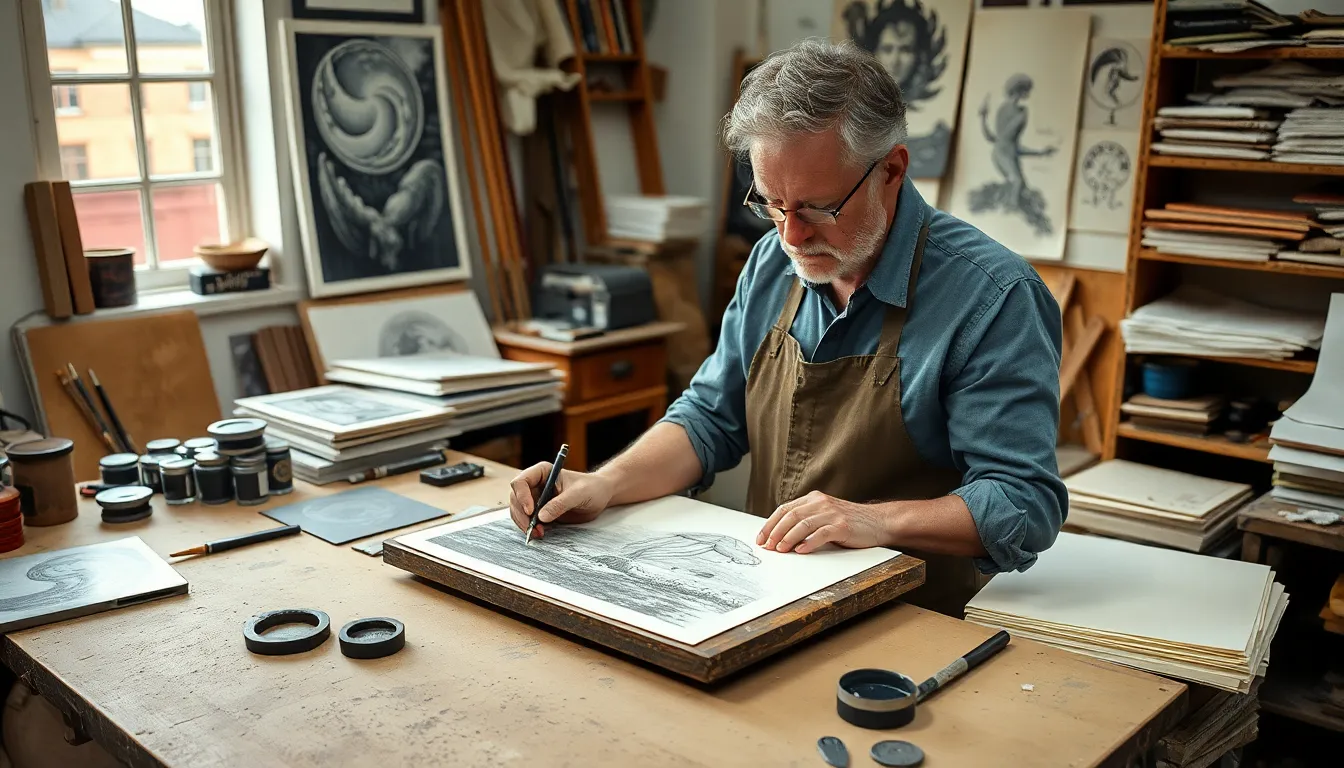Fine art prints are like the stylish friends who always show up to the party—elegant, eye-catching, and ready to impress. They transform blank walls into vibrant conversations, making any space feel more alive. Whether it’s a stunning landscape or a quirky abstract piece, fine art prints add a splash of personality that says, “Yes, I have taste!”
But let’s face it; not everyone can afford an original masterpiece. That’s where fine art prints come to the rescue! They offer a budget-friendly way to enjoy beautiful art without breaking the bank. With countless options available, anyone can find the perfect print to match their style. So, why settle for boring walls when you can elevate your space with art that speaks to you? Dive into the world of fine art prints and discover how they can redefine your environment with flair and fun.
Table of Contents
ToggleOverview of Fine Art Prints
Fine art prints stand out for their ability to inject personality into any space. These artworks offer a cost-effective solution for those seeking quality without the hefty price tag of originals.
Definition and Characteristics
Fine art prints represent high-quality reproductions of original artworks. They typically utilize archival inks and durable paper for longevity. Collectors value their authenticity, often indicated by limited editions or artist signatures. Each print captures the essence of the original piece, offering a unique visual experience. Artists commonly produce prints using various techniques, ensuring a wide range of styles and effects.
Types of Fine Art Prints
Various types of fine art prints exist, showcasing different techniques and aesthetics. Giclee prints utilize inkjet technology for superior color accuracy. Lithographs involve transferring images through stone or metal plates, creating distinct textures. Screen prints, also known as silkscreens, apply layers of ink through a mesh stencil. Etchings, produced by incising a plate with acid, reveal intricate details. Woodcuts, created by carving images into wood blocks, offer bold, graphic illustrations. Each type has its own unique appeal, catering to diverse tastes in art.
Techniques Used in Fine Art Prints

Various techniques form the backbone of fine art prints, each offering unique characteristics and aesthetics. Understanding these methods enhances appreciation for the artistry involved.
Lithography
Lithography involves transferring images onto a flat surface, commonly stone or metal. Artists utilize a grease-based medium to draw on the surface. The non-image areas are treated with water, allowing ink to adhere only to the image. This technique produces crisp lines and vibrant colors. Specific papers absorb ink well, ensuring quality results. Lithographs can be produced in limited editions, adding value for collectors. The process has historical significance, dating back to the late 18th century.
Etching
Etching utilizes a metal plate coated with a waxy ground. Artists engrave their designs into the ground, exposing the metal beneath. Immersing the plate in acid bites into the exposed areas, creating grooves. After cleaning, the plate receives ink, which fills the grooves. Pressing paper onto the inked plate transfers the image, showcasing fine detail and texture. Etchings allow for unique expression through variations, such as color or texture. Their intricate methods resonate with collectors seeking depth in artistry.
Screen Printing
Screen printing relies on a stencil-based approach to transfer images onto various materials. Artists create a mesh screen for each color used in the print. Applying ink through the screen onto the surface produces bold shapes and vivid hues. This method suits a range of substrates, including paper and fabric. Limited runs enhance the collectible appeal of screen prints. Featuring diverse styles, from graphic to abstract, screen printing continues to evolve, attracting artists and audiences alike.
Choosing the Right Fine Art Print
Selecting a fine art print enhances any space and reflects personal style. The right choice elevates an environment and creates a unique atmosphere.
Factors to Consider
Size greatly impacts the overall effect of a fine art print. Small prints suit intimate spaces, while large prints make bold statements on expansive walls. Material influences durability and aesthetic appeal; archival paper ensures longevity while canvas offers texture. Frame style complements the art and aligns with existing decor. One should also consider color palettes that harmonize with the room’s hues. Price varies significantly based on techniques, artist reputation, and edition size. Establishing a budget streamlines the decision-making process without sacrificing quality.
Popular Artists and Styles
Famous artists dominate the fine art print market, catching the attention of collectors. Gustav Klimt and his intricate, golden patterns often inspire admiration. Andy Warhol represents pop art, known for vibrant colors and cultural commentary. Photographing iconic images offers distinct appeal, with Edward Weston specializing in natural forms. Contemporary artists also shape the landscape, including Yayoi Kusama with her bold patterns and immersive installations. Fluid styles, from abstract expressionism to minimalist designs, attract diverse tastes, ensuring an extensive selection for every collector.
Caring for Fine Art Prints
Caring for fine art prints ensures their longevity and maintains their visual appeal. Proper handling, storage, and display techniques protect these pieces from damage and fading.
Storage Tips
Keep fine art prints in a cool, dry environment to prevent moisture damage. Use acid-free materials when storing, including sleeves and boxes, to avoid deterioration. Light exposure should be minimized; store prints in dark locations or in UV-filtering boxes. Flat storage is ideal to avoid creasing or bending; consider using portfolio cases for easy access and protection. Avoid stacking prints directly on top of each other to prevent abrasion or scratching.
Display Guidelines
Choose locations away from direct sunlight to safeguard the colors of fine art prints. Frame prints using UV-protective glass to mitigate fading caused by light exposure. Ensure the mounting materials are acid-free to prevent discoloration over time. Hang prints at eye level for optimal viewing and appreciation. Regularly dust frames and glass surfaces to maintain clarity, using microfiber cloths to keep them clean without scratches.
Fine art prints offer a unique opportunity to enrich any space with personality and style. Their affordability and variety make them accessible to a wide audience, allowing anyone to enjoy the beauty of art without breaking the bank.
With various printing techniques and styles available, collectors can find pieces that resonate with their tastes and enhance their environments. Proper care and thoughtful selection ensure these prints remain vibrant and captivating for years to come.
Exploring the world of fine art prints can inspire creativity and elevate one’s living or working space, making it a worthwhile endeavor for art lovers and casual admirers alike.



